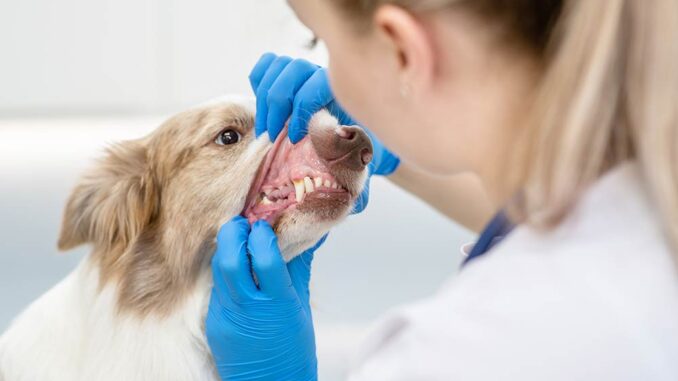
This article was updated on August 31st, 2023
While conducting a routine exam on a patient, I noticed a few of his teeth were brown. I checked his record and discovered that he hadn’t had a dental cleaning in a few years. So, I spoke with the owner, explained that a few teeth were looking brown, and recommended an appointment to clean his teeth. I told my client that there are various causes of brown teeth, and it may be simple tartar buildup, but I would be better able to evaluate the teeth while the dog was under anesthesia.
In this article, we’ll discuss the causes of brown teeth in dogs and other symptoms you may notice. Then, I’ll help you know when you should call your vet for an appointment.
Are brown teeth in dogs serious?
Healthy dog teeth should appear clean and white. However, as your pup ages, his choppers can become stained or discolored. Some causes of abnormal coloration in teeth are external, such as staining, but others are due to internal conditions, including dead and rotting teeth. When you notice discolored or brown-stained teeth in your dog, it could point to something serious. Schedule an exam with your veterinarian.
What causes brown teeth in dogs?
Tartar is not the only reason dog teeth can turn brown. Dog teeth can turn brown due to extrinsic causes, such as tartar or stains, or intrinsic causes like injuries or infections.
Extrinsic causes:
1. Tartar/gum disease
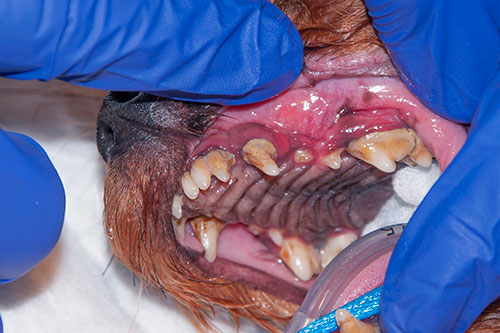
When dogs eat, a film of bacteria known as plaque forms on the surface of the teeth. If you don’t brush your pup’s teeth, the film hardens and mineralizes, creating tartar. When dogs develop tartar, you may also observe:
- Yellow-brown tooth discoloration
- Bad breath
- Reddened gums
- Bleeding gums
Usually, tartar is a symptom of periodontal(gum) disease in dogs. If left untreated, it can eventually lead to infections, tooth abscesses, or tooth loss. Tartar is extremely difficult to remove from the tooth’s surface. Call your veterinarian to schedule a dental cleaning. Routine procedures usually cost around $300-700.
How do I know if my dog needs veterinarian’s help because of tartar issues?
Tartar is one of the leading causes of brown teeth, so let’s start by reviewing several pictures of dogs with tartar issues and discuss what needs to be done for each.
1. Mild brown teeth: if your dog’s teeth are showing a ring of brown at the gums with a little inflammation, you’re not doing too bad. But now’s the time to get in there and get something done. Tooth brushing, dental gels, sprays and wipes should break up this tartar. Dental chews may also help. Learn about the best ways to remove tartar on dogs’ teeth.

2. Moderate brown teeth: if your dog has teeth like these but isn’t painful, you may start with some dental chews, brushing, gels, or wipes. Give these products a couple weeks of regular use and see if you’re making any progress. If not, it’s time to visit your vet.

3. Severe brown teeth: you are better off with professional veterinarian help. Chances are your pup is experiencing some pain and other dental products will just take too long to work. Get them in for a dental checkup and cleaning to hopefully prevent any tooth loss.

2. Stains
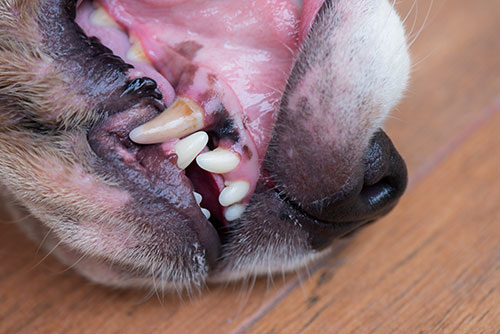
Dog teeth can become discolored by external sources that stain the surface of the enamel including:
- Food stains – Certain foods like blueberries or beets can leave brown stains.
- Metal – Some dogs chew on metal, and it can leave brown stains. This behavior can also damage the teeth, so discourage your dog from doing it.
- Medications – Some antibiotics like tetracyclines can interact with proteins in the enamel and cause brown stains.
- Bleeding gums – When a dog’s gums are bleeding, the dried blood can leave brown stains from iron in the hemoglobin after saliva digests the blood cells.
When the enamel surface becomes stained, you will see tooth discoloration, but the gums will remain healthy and pink in appearance. Unless there are other conditions going on, your dog’s breath won’t stink. Extrinsic staining can usually be removed either with a dental cleaning or by using a cosmetic approach such as bleaching or veneers. A basic dental cleaning usually runs $300-700, but additional measures can increase the overall cost.
Intrinsic causes:
3. Trauma
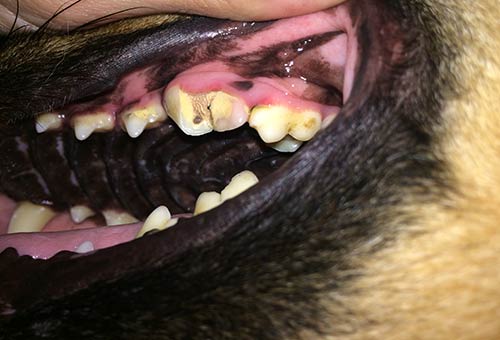
When your dog suffers trauma that causes injury or fracture to one or more teeth, it can result in discoloration. The condition compromises the tooth’s integrity by damaging the enamel and inner protective layers. Signs of tooth trauma include:
- Abnormal coloration on the crown or around the tooth
- Evidence of a fracture
- Facial swelling
- Dropping food or chewing on one side
- Excessive drooling
- Refusing to chew kibble or hard toys
If the tooth is salvageable, your vet may recommend a crown or other way to repair it. The cost to remove any damaged pulp and cap the tooth can cost approximately $1100-3800. If the tooth is severely damaged, extraction runs about $150-650.
4. Infection/abscess
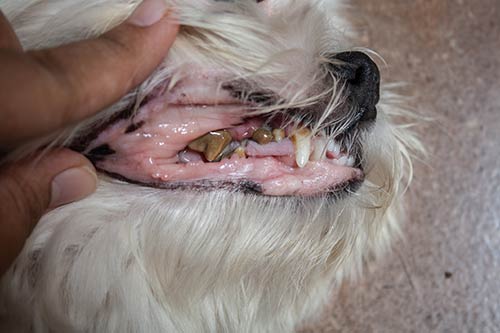
With severe periodontitis, the bacteria can infect the tooth and cause decay. When the tooth turns brown, it indicates the pulp is dead. Signs of tooth decay include:
- Bad breath
- Tooth covered with tartar/calculus
- The tooth may be brown or gray
- Inflammation of the gums
- Excessive drooling that may be ropey
- Bleeding gum line
- Receding gum line
- Loose teeth
- Swollen face
- Bleeding from the gums/mouth
- Pawing the face
- Dropping food or difficulty chewing
- Head shyness
Rotting teeth are a serious condition in dogs. If left alone, the infection may spread and cause sepsis. Decay is also very painful for your pooch. If you see signs of tooth decay, schedule a dental cleaning and oral examination(cost listed above) with your veterinarian. The doctor will evaluate the affected teeth to determine whether they are salvageable.
If the teeth are viable, your vet may perform a root canal. The cost for most dogs is about $1000-3000, but it may be higher for large or giant-breed dogs. Severely decayed teeth will be extracted. The cost is listed in the section above.
5. Elevated blood bilirubin
When old red blood cells die, the body processes them and produces bilirubin. The byproduct travels to the liver and mixes with bile in the gallbladder. Later, it’s excreted from the body through the feces. When bilirubin increases in the blood, it may be a sign of liver disease or a related condition. Symptoms of elevated bilirubin can include:
- Tooth discoloration
- Jaundice or yellow eyes/skin/gums
- Changes in urine color
- Vomiting and diarrhea
- Loss of appetite
- Lethargy
When dogs have increased levels of bilirubin, your veterinarian will run bloodwork, take a urine sample, and run other tests to find a diagnosis. Depending on the results, treatment may include
- Dietary modifications
- Blood transfusion if your dog is anemic
- Antibiotics if infection is present
- IV fluids and electrolytes as supportive care
- Medicines or supplements to reduce ammonia
- Anti-inflammatory medicines
The cost to treat conditions that cause elevated blood bilirubin varies widely depending on the diagnosis. Simple diseases may cost a few hundred dollars, but severe conditions can cost several thousand dollars.
Other symptoms to worry about if your dog has brown teeth
Dogs with discolored teeth should see the veterinarian for an oral examination. However, certain symptoms can tell you that your dog’s condition is probably serious.
- Bad breath
- Dropping food or difficulty chewing
- Swollen, reddened, or bleeding gums
- Excessive saliva
- Head shyness
- Rubbing or pawing at the face
- Loss of appetite
- Depression or lethargy
- White gums from blood loss
- Eye or nose discharge/sneezing
When to consult with a vet
When your dog has teeth with a brown stain or discoloration, you need to consult with your veterinarian. While some conditions like food stains are minor, others like broken teeth and infections can be extremely serious. These diseases won’t improve with time; they require treatment. Delaying veterinary care can result in more severe conditions.
Would a vet be able to help over a video call?
If budget is a concern, you may be able to use a video call to help you determine the severity of the stains. The doctor can ask you questions about your dog’s history and symptoms as well as your observations. You may also be able to send a picture of your dog’s mouth/teeth for evaluation.
However, the veterinarian will not be able to run diagnostic tests or complete a physical examination of your dog, Reaching a definitive diagnosis is unlikely without an office visit. Therefore, your veterinarian will not be able to recommend the best treatment plan.
Frequently asked questions
Can brown teeth cause health issues in dogs?
Brown teeth can be a sign of serious health issues in your dog. Tooth abscesses or decay indicate an infection that can lead to sepsis without treatment. High bilirubin may point to liver disease or related conditions that affect the liver.
How often should I brush my dog’s teeth?
Brushing your dog’s teeth once a day can help remove food debris and prevent plaque and tartar buildup. Do not use human toothpaste, because it may contain ingredients that are dangerous for dogs. Select a pet-safe product like Petrodex Enzymatic Toothpaste.
What can I do to prevent brown teeth in my dog?
Some preventative measures you can take include:
- Brush your dog’s teeth daily
- Schedule regular veterinary exams to maintain your dog’s health
- Schedule periodic dental cleanings to remove plaque and tartar buildup
- Select food and treats that support dental health
- Give your dog soft toys to gnaw to prevent injury or fractured teeth
Are there any breed-specific risks for dental problems?
Certain breeds and breed types are at higher risk for dental disease:
- Brachycephalic breeds like pugs and bulldogs
- Toy-breed dogs like Chihuahuas and Yorkshire terriers
- Dachshunds
- Small breeds like poodles and Cavalier King Charles Spaniels
Disclaimer: This website's content is not a substitute for veterinary care. Always consult with your veterinarian for healthcare decisions. Read More.



Be the first to comment